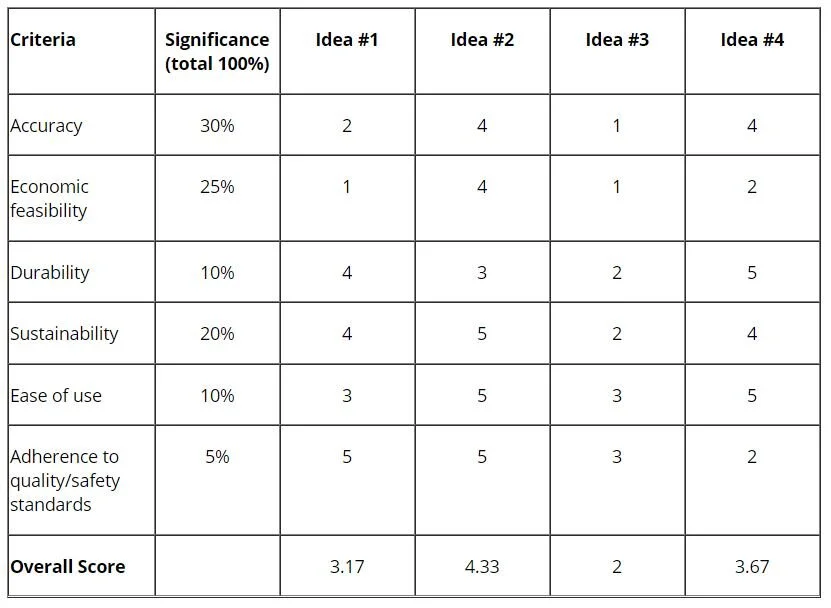
GLOBAL HEALTH TECHNOLOGY CERTIFICATE
Module 3: Brainstorming and Development
STAGE 1: Idea Generation
This stage in effective technology design is critical. Even though it may not be known at the time, one seemingly minute idea from the brainstorming session may ultimately constitute the basis of the final innovation. Therefore, the suggested guidelines for brainstorming are meant to encourage idea proliferation. While the process of brainstorming is more effective in a group setting, these rules apply similarly for individuals who are generating new ideas alone.
First, always defer judgment. Support wild ideas. Use written, visual, and oral aids. Build on the ideas of others by using “and” instead of “but.”(1) Maintain focus but do not hesitate to address relevant issues. Break the whole into parts, and devise solutions into components. Consider current or existing technologies and identify the benefits and drawbacks. Make connections and explore unknown territory.
Begin by creating opportunity areas.(2) Considering the global health challenge, pose “How might we…?” questions to set the stage for idea generation. At this point, the emphasis is on quantity, not quality. Although it may be tempting to prohibit yourself or others by rejecting ideas that do not seem feasible or appropriate, the beauty of this stage is that no idea is off-limits. Despite having established a well-defined global health challenge and a set of measurable design criteria, it is more effective when ideas are allowed freedom in creation, and are not generated around any certain design requirement. This is the time to let creativity run.
Stage 2: Evaluation by Decision Matrix
Using measurable design criteria from Stage 4 of Module 1, you can now evaluate the list of technology produced from brainstorming, and narrow selection to the top 3 to 5 ideas that will undergo further consideration. This process can be easily achieved and organized by the Decision Matrix method (also known as the Pugh method). Using a series of rows and columns, innovators can score potential options by multiple criteria to quantitatively sum and rank options.
A sample decision matrix is provided for reference below. Note the design criteria along the left-hand side, followed by a column distinguishing the weight of significance per criterion, and the options garnered from brainstorming along the column titles. If design criteria are properly selected for the ability to be measured against a standard scale, ratings for each criterion can be averaged to give an overall score for each brainstorm option.
This process has been borrowed from Task 6 in a course guide for Appropriate Design in Global Health, created by the Institute of Global Health Technologies at Rice University. An example Decision Matrix, using ratings according to a common scale (values of 1 to 5) follows:
The advantage of this method is that selection among ideas can be more objective. Decisions on preferences are made based on purposive grounds that fit the needs of the desired technology. A decision matrix also demonstrates sensitivity among preferences by comparing weighted criteria and identifying what options are ranked higher in which category.
Stage 3: Prototyping
With 3 to 5 “top ideas,” it is time to make these ideas tangible. This stage is intended to start answering questions that will give value to the final design. Prototypes “build to think,” and may take various forms:
3-D models or mock-ups – give physical depiction
Storyboards – give serial experience of the design
Role-play – gives emotional experience
Diagrams – gives space, structure, and relationships(3)
The process of prototyping is not about perfection. It is meant to help understand the ideas generated during brainstorming and preliminary evaluation, and to answer questions that will begin to give value to select designs that will move further through the design process. For instance, IDEO suggests using prototypes to answer the following questions:
Who will benefit from this idea?
What is the value to the end customers?
Why and how is this idea better than alternative options?
How much is this benefit worth to them?
How much would they be willing to pay for this benefit?
Footnotes
(1) IDEO. “Human-Centered Design Toolkit, 2nd Edition.” https://www.ideo.com/post/design-kit.
(2) Ibid.
(3) Ibid.

